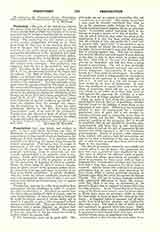

Presbytery. —The part of the church reserved for the higher clergy was known in antiquity by various names, among them presbyterium, because of its occupation during the liturgical functions by the priests attached to a church, arranged in a half-circle round the bishop. The presbytery was also known as apsis, exedra, concha, designations referring to its form; bema from the fact that it was elevated above the level of the nave and in consequence reached by a stairway of a few steps; tribuna because of its location and general resemblance to the tribunal in civil basilicas whence the magistrates administered justice. These various names were, in the Middle Ages, mostly superseded by the term choir, which in turn yielded to the modern term sanctuary. The presbytery was separated from the rest of the church by rails (cancelli). Eusebius, in his dedication oration at Tyre (H. E., X, iv), describes this feature of the church and its objects: “the Holy of Holies, the altar”, he explains, was inclosed with wooden lattice-work, accurately wrought with artistic carving to render it “inaccessible to the multitude”. In Constantinople, as appears from the episode related by Theodoret in which the actors were Theodosius the Great and St. Ambrose, the emperor was accustomed to remain within the precincts of the presbytery during the celebration of the liturgy, but in the West this was not permitted (Theodoret, H. E., V, 17). The Council in Trullo (canon lxix), following an ancient tradition, specifically excepts the emperor from the general rule reserving the presbytery to the clergy. From this strict prohibition relative to the laity the term adyta (inaccessible) came to be used of the presbytery. Presbyterium also denoted a body of priests taken collectively. In modern times the house of the clergy is frequently called the presbytery (presbytere).
MAURICE M. HASSETT

